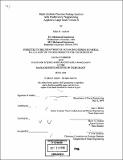Multi-attribute decision making analysis with evolutionary programming applied to Large Scale Vehicle II
Author(s)
Andrew, Allan D. (Allan David), 1966-
DownloadFull printable version (7.591Mb)
Alternative title
Large Scale Vehicle II
Advisor
Alan J. Brown and Harry A. Jackson.
Terms of use
Metadata
Show full item recordAbstract
Ship and submarine design is a very complicated process that requires many trade-offs in design parameters in order to obtain the optimal vehicle effectiveness at the best cost. The number of potential designs is infinite, and the ship designer needs a tool to assist in searching this design space. This thesis uses an evolutionary program to determine the optimal designs of Large Scale Vehicle II, a one-quarter scale submarine model used for propulsor development. A set of designs is randomly generated and represented by binary strings. Each design is treated as an individual in a biological population and evaluated for total ownership cost and two measures of effectiveness. Measures of effectiveness obtained through expert opinion and computer modeling are explored. The designs with high effectiveness and low cost are chosen to produce offspring while the designs with poor effectiveness and high cost are removed from the population. Over many generations, the designs that yield high effectiveness dominate the population. No single design is identified as the optimum. Instead, the information is presented to the decision-maker on a two-dimensional plot that represents the frontier of all non-dominated designs. Each axis represents one of the measures of effectiveness and each level of cost is plotted on a separate curve. This process allows the decision-maker to choose one or several of the non-dominated designs to continue through feasibility and detailed design.
Description
Thesis (Nav.E. and S.M.)--Massachusetts Institute of Technology, Dept. of Ocean Engineering, 1998. Includes bibliographical references (p. 117-118).
Date issued
1998Department
Massachusetts Institute of Technology. Department of Ocean EngineeringPublisher
Massachusetts Institute of Technology
Keywords
Ocean Engineering